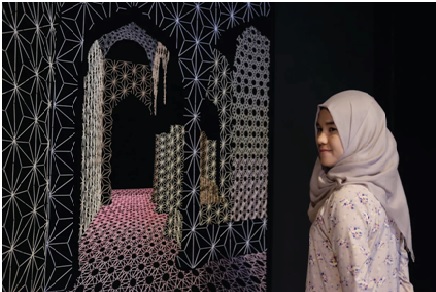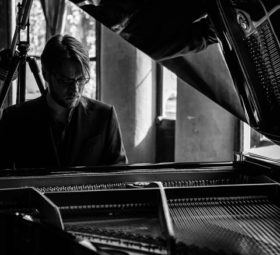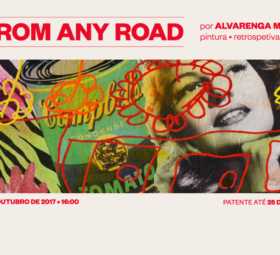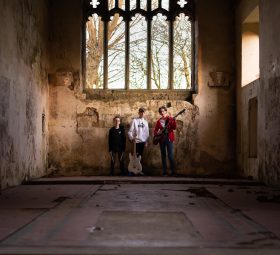
A Journey Among the Stars By CLAUDIA ACHA
Meet Mariem, Thidarat Chantachua, a trailblazing Chinese-Thai Muslim artist who is getting ready to hit Art Stage in Singapore on January 26.

Mariem with her work, “The Dimension of Faith” (2015).
Her latest piece, “Restart,” is the centerpiece of her exhibition in Singapore. This installation brings awareness to immigration issues and the refugee crisis. Mariem’s roots trace back to China. Her family’s experiences as Thai Muslims living in Bangkok opened her eyes to the constant mobility of our generation. She portrays this flow through a tent; a tent that is not perfect but nonetheless serves as a home. Mariem stitched a path of stars inside the tent. The stars, she explains, led the migrants to their home. The embroidery inside the tent creates a deeper experience for the viewer and transports them to a different dimension. Mariem was influenced by Yayoi Kusama’s work, the internationally renowned Japanese artists famous for her Infinity Mirror Rooms.
Mariem transferred her embroidery from the canvas to an installation because she wanted to use space to play with perception and make viewers feel more. Her patterns create dimensions and help viewers understand that there are many different ways of seeing reality. Quotes from news sources cover the tent. One of the phrases reads, “Welcoming refugees is a ???” Viewers are deliberately challenged to think about this open question.
![]()
“Restart,” is covered by quotes from the news. One of them reads, “In many cases we learn that one ticket from the authority affects the demolition of many buildings belonging to families.”
The blending of embroidery with paint gave birth to an avant-garde style, ingeniously combining traditional Arabic techniques with new concepts. When asked if she was breaking any rules in Islam through her innovative work she responded, “Using Muslim elements to create art is not breaking any rules. In art, there is no right or wrong. There are no rules.” Her inspirational spark came from a Muslim story that explains that the stars emerged from a flower that blew from the earth to the sky. She felt that this story would be more obvious to viewers if she filled the entire canvas, representing the sky, with patterns.
Mariem’s semi-abstract art arose from a desire to innovate and evolve, “Many people already made thousands of paintings and sculptures. I wanted to do something different. If I did traditional paintings and sculptures, then I wouldn’t be learning.” During her first 3 years in university, Mariem was quiet, kept to herself, and didn’t explore new techniques. However, a realization came in the last year and she felt that it was time to change. Before discovering her unique style, Mariem explored several techniques. Her journey began with abstract art, but it didn’t allow her to guide the viewer’s attention as she hoped. She then created collages and portraits, but they didn’t keep her engaged. Mariem showed her professor an embroidery piece she made and asked him for guidance. He suggested that she try embroidery on a canvas. Although she was hesitant, Mariem blended a canvas with paint and embroidery.
The result was beautiful artistic alchemy. A breakthrough in Arabic art, her mixed media and semi-abstract approach create an immersive experience for viewers. When you see Mariem’s art, you are transported to another world. Mariem was certain that this style suited her because by threading she could, “meditate and learn to strengthen her mind and soul.”
![]()
Mariem’s “Point of Faith” (2016) is part of her On the Path of Different Cultures project.
In “Point of Faith,” Mariem strings cultures together by illustrating a borderless Japanese temple and Islamic mosque. A sense of harmony arises; as if two separate buildings, cultures, and religions become one through each thread. Jongsuwat Angsuvarnsiri, the curator of On the Path of Different Cultures, Mariem’s first solo exhibition, views the cultural bond as, “A bond that alludes to the unity in humanity, telling us that we can grow stronger when we stay together.” Mariem traveled around Europe and Asia for this project. She wanted to see how other people view religion, culture, and politics. Her artworks from that project focus on the possible harmony among religions.
Unlike most artists, Mariem doesn’t come from a family of artists. However, she’s always liked the arts. She started painting when she was a little girl and even taught herself to stitch. Mariem’s family couldn’t afford to hire someone to sew her name on her school uniform so she taught herself. Despite her international recognition and a degree from Thailand’s leading arts university, Mariem’s family was reluctant to praise her successes. They always wanted her to get a normal job in an office. Now, however, they help Mariem with the embroidery for her works.
One of the most inspiring things about Mariem is her perception of success. She views success not as in what she can get but what she can give. “It’s about giving, not getting.” Despite her humble beginnings, Mariem didn’t get lost in the fame or material gains from her art. What she is happy about is that she has a voice now. A voice that she can use to inspire. Mariem measures success in terms of her ability to influence people. She hopes her art inspires other artists to create innovative Islamic art. Mariem’s success also gave her the confidence to build an art institute. Through calligraphy, embroidery, and painting workshops, she envisions the elimination of division among Thai Muslims.
![]()
“Prostate Oneself 3” (2015) embroidery/acrylic on canvas.
“Prostate Oneself 3,” is one of her favorite works. It depicts people connecting through prayer. Her creativity eliminates boundaries through each thread. Mariem doesn’t include the image of a god because she doesn’t want her art to restrict people to one religion. Instead, she wants viewers to connect with the people portrayed instead. Perhaps that’s why Jongsuwat is so moved by her work, “When we open our hearts and embrace the difference without looking from just one angle, we will find that there are so many people out there who are willing to offer friendship and kindness. When we are able to do that, perhaps we may be just that much closer to peacefulness.”
![]()
“Nowhere” (2016) is a piece Mariem created from her travels around Asia and Europe.
Mariem’s threads reestablish human bonds in a constantly evolving world and illustrate the importance of creating harmonious multicultural communities that embrace differences.
The threads in “Similar Differences,” show just that.
![]()
“Similar Differences” (2016) by Thidarat Chantachua.
Claudia is a travel blogger who focuses on Southeast Asian street art and culture. You can follow her on
Instagram @nomad.lyfe or email her nomad.lyf3@gmail.com
Claudia Blog : Click Here














0